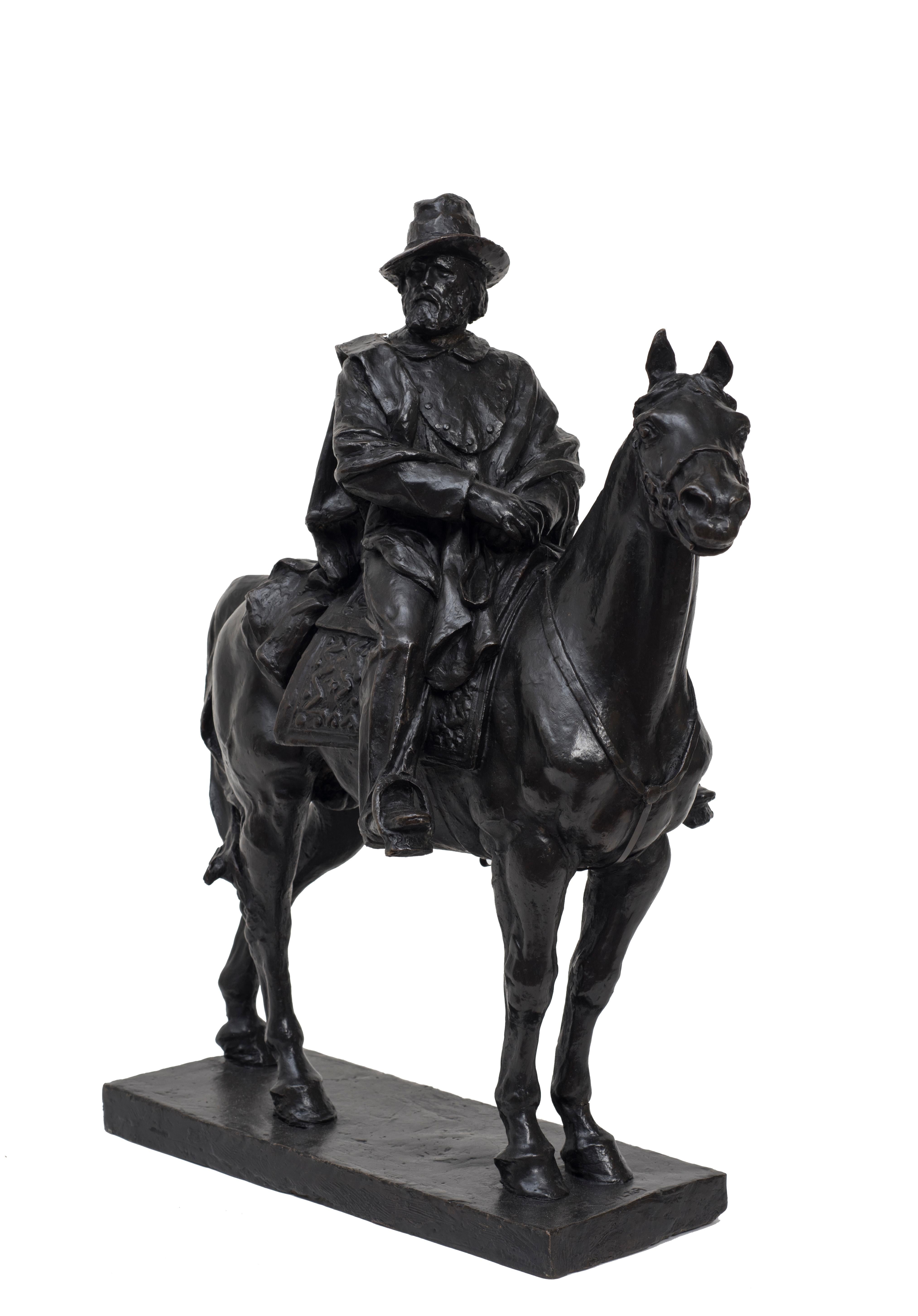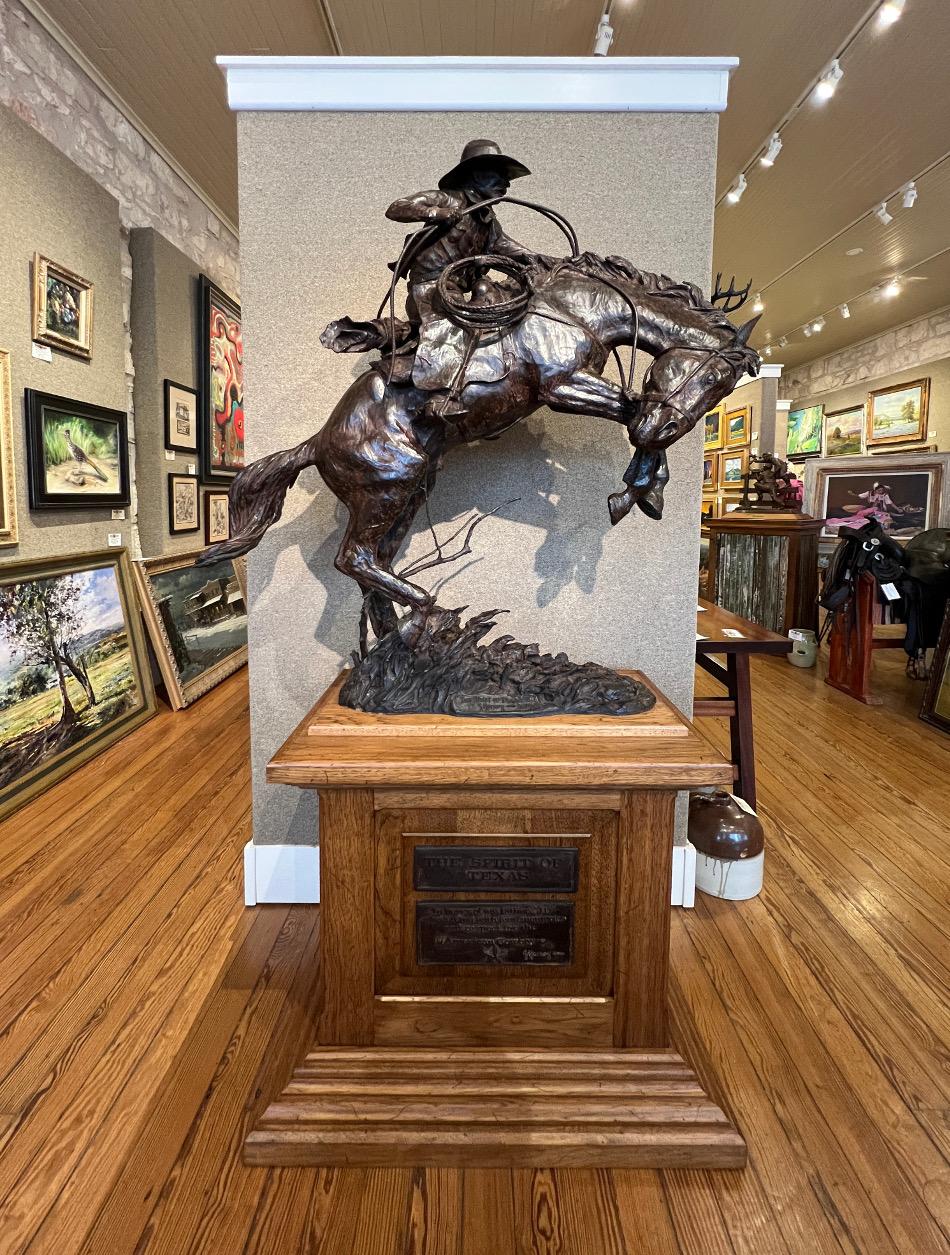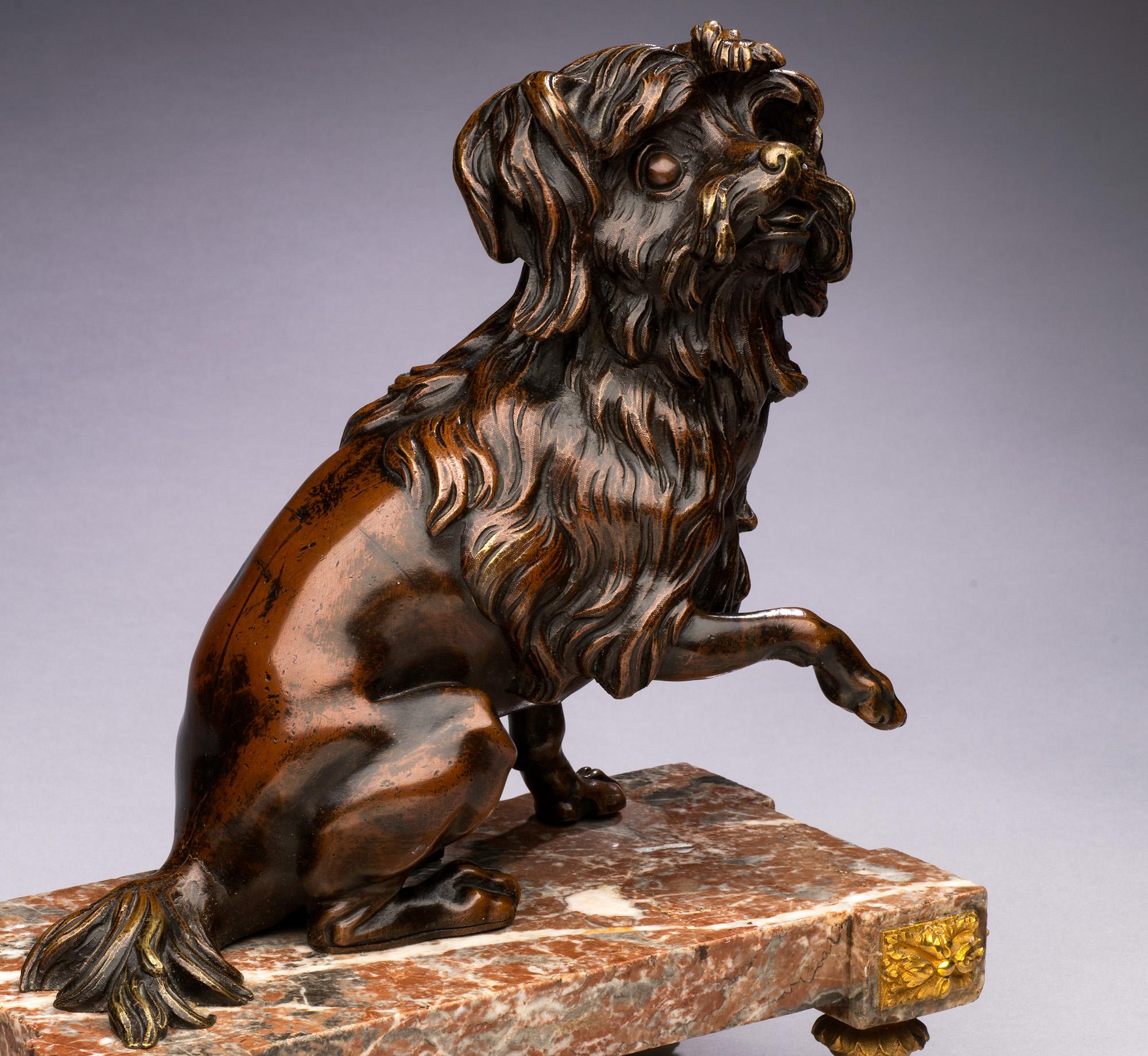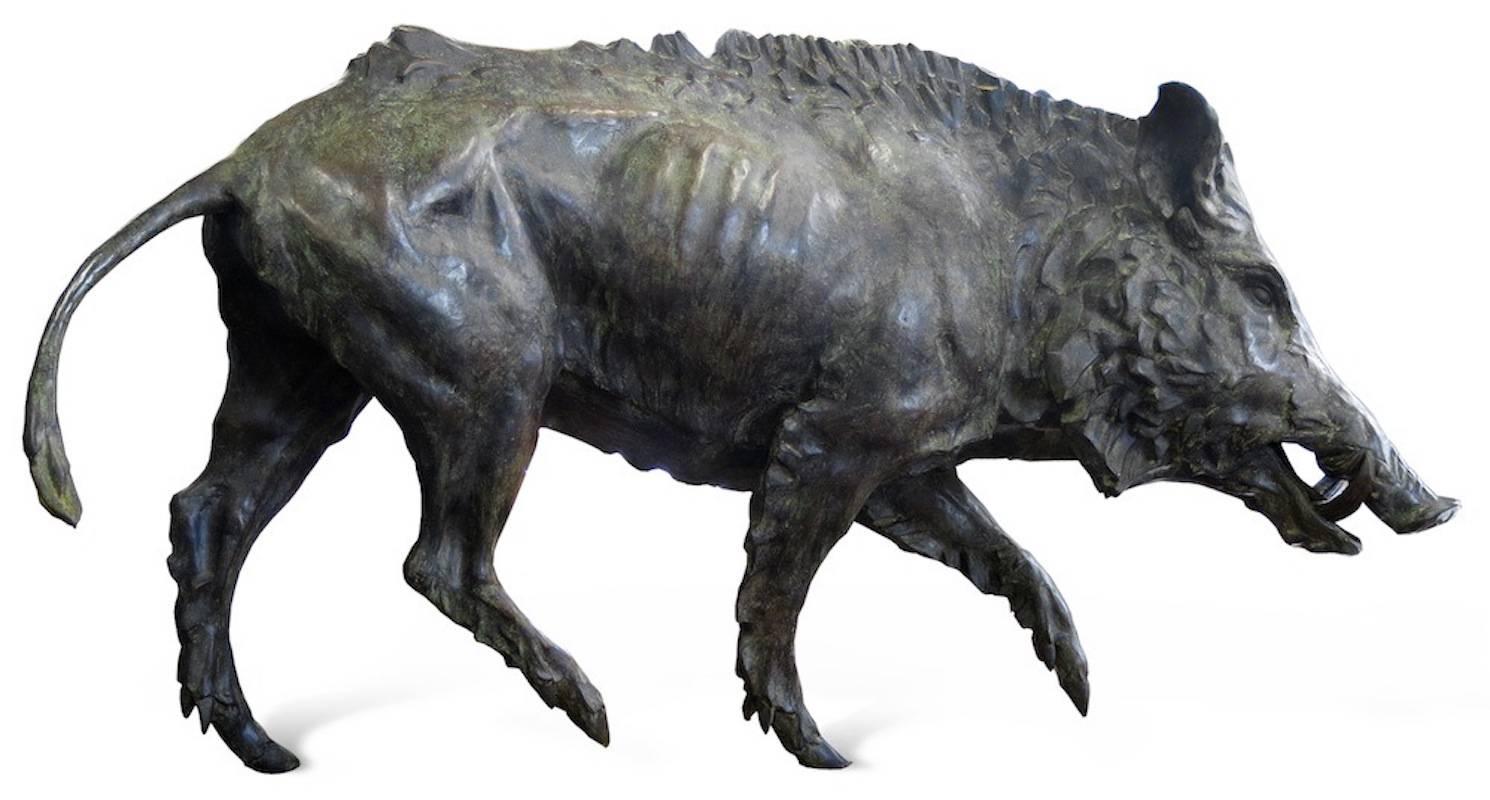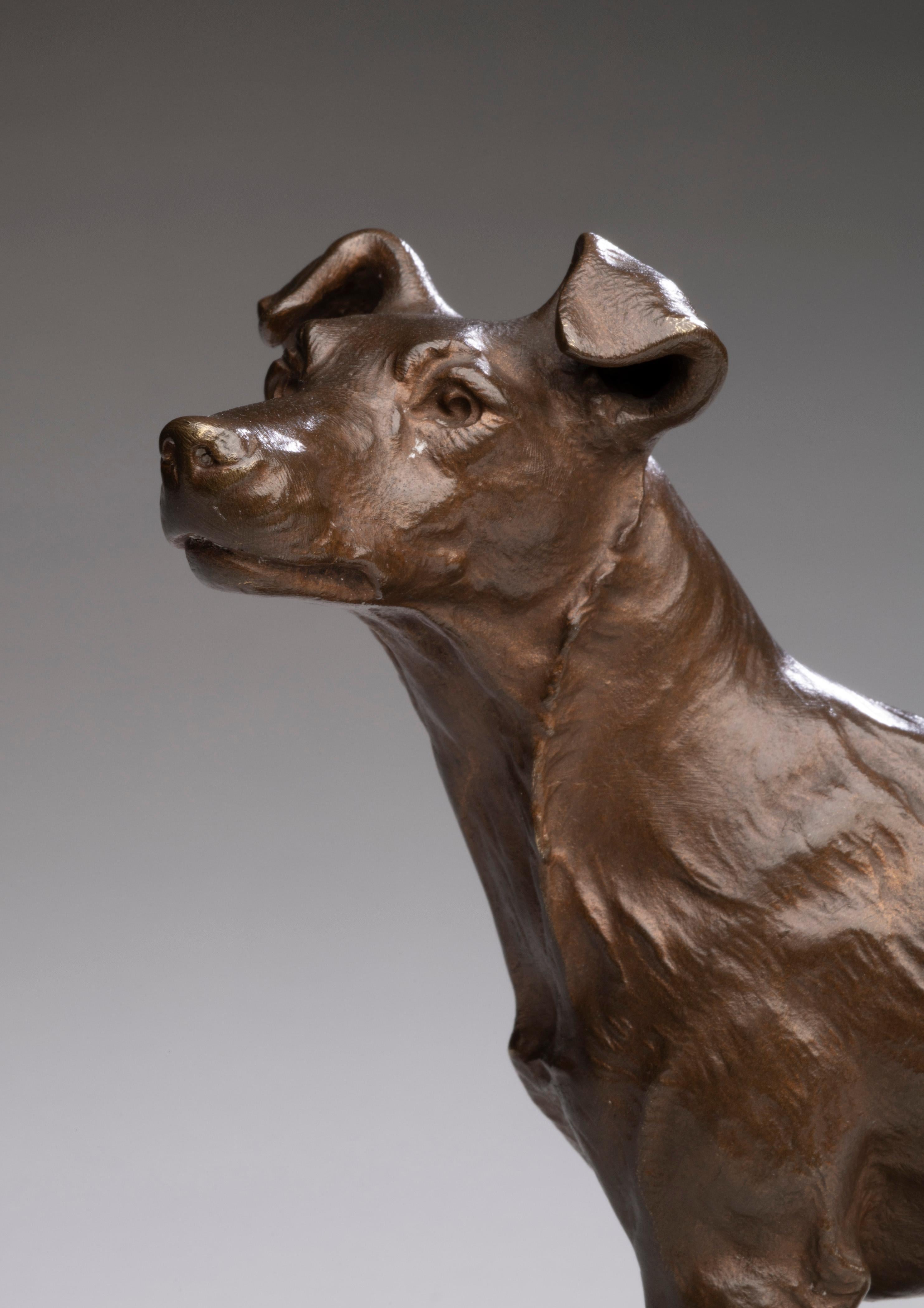Items Similar to Don Quixote
Want more images or videos?
Request additional images or videos from the seller
1 of 2
Agenore FabbriDon Quixote
About the Item
Fabbri was born in Quarrata (Tuscany). At the age of 12, he attended the Scuola d'Arte in Pistoia and then, under the instruction of the painter Fabio Casanova, he decided to embark on an artistic career and created his first sculptures, mainly using the wax and plaster.
In 1932 Fabbri, in order to continue his education at the Accademia di Belle Arti, moved to Florence where he frequented the artists' Caffè Giubbe Rosse, meeting point for the intellectuals known as the Ermetici Group (Eugenio Montale, Carlo Bo, etc.) and also came into contact with the painter Ottone Rosai and the poet Mario Luzi. At the end of the year he moved to Albisola (Savona), where he worked in the La Fiamma (The Flame) ceramic workshop and created his first terracotta sculptures, mainly biblical figures.[1] In 1933 he made friends with Tullio Mazzotti (better known by the name of Tullio d'Albisola), who owns the Giuseppe Mazzotti (Tullio's father) ceramic factory in Albissola Marina. It is here that the most significant artists of the second generation of Futurism worked under the patronage of Filippo Tommaso Marinetti: Fillia, Antonio Sant'Elia, Nicolaj Diulgheroff, etc. Later he established a small studio and came into contact with Arturo Martini and Lucio Fontana with whom he began a friendship until Fontana's death (1968).
In 1935 participated in the Mostra Nazionale in Naples while in 1938 received the Bagutta-Spotorno Award for the bronze II piccolo pescatore (The Little Fisherman), which was bought by the Museum of Modern Art, Milan on the advice of Arturo Martini. In the early 40s, Fabbri made his debut with his first solo exhibitions at the Gian Ferrari Gallery, Milan (1940) and then in Bergamo and Savona but shortly World War II and military service interrupted his career and he was sent to Yugoslavia and Greece.
In 1946 took up residence in Milan and during the summer months worked in Albisola, in the Mazzotti ceramic factory, where all his most significant terracotta sculptures were created. In the years after the War, Albisola again became a centre for art of international importance where Marino Marini, Giacomo Manzù, Aligi Sassu and Karel Appel, Guillaume Corneille and Asger Jorn from the COBRA Group, as well as Roberto Matta and Wifredo Lam worked. Later artists such as Giuseppe Capogrossi, Roberto Crippa, Gianni Dova, Emilio Scanavino and the young enfant prodige Piero Manzoni also arrived.
In 1947 he had his first meeting with Picasso in Vallauris and created terracotta and ceramic works such as Donna del popolo (Lady of the People, name given by Picasso himself), Uomo colpito (Struck Man) and La madre (The Mother).
In 1956, invited by the Chinese Government, he travelled to China for three months with Antonietta Raphael Mafai, Giulio Turcato, Aligi Sassu and others. His work was greatly influenced by this journey over the next few years. From 1958 onwards he made his debut on the international scene with solo exhibitions in the United States, New York City and Philadelphia, and in Europe, London, Paris, Stockholm, Rome and Milan as well as he was invited to numerous national and international group exhibitions of sculpture all over the world: the Venice Biennale in 1952 and 1960 (both with a solo room) and those of 1959 and 1964, as well as the Rome Quadriennale and then in Antwerp, Madrid, Paris, Zurich, Athens, The Hague, Munich, London, New York City, Boston, Tokyo, Sao Paulo, Mexico City, Cairo and Alexandria in Egypt.
In 1965 Fabbri was voted into the Accademia Nazionale di San Luca, Rome and in 1967, he illustrated ten poems by Nobel Prize Salvatore Quasimodo who, after a long friendship, had dedicated an open letter to Fabbri which was published in the Italian weekly magazine Tempo on the occasion of his solo exhibition at the Borgogna Gallery, Milan.
In the 80s his work was exhibited mainly in Germany with major retrospectives at the Lehmbruck Museum, Duisburg, the Ludwig Museum, Cologne, the Sprengel Museum, Hannover and the Fellbach Triennial. In 1984, the Spanish poet Rafael Alberti, who had been a friend of Fabbri's for many years, wrote forty poems about his work; at the same time, a book and a documentary film featuring both artists was produced while in 1991, as a designer for Tecno Milan, he created a bench that is still widely distributed in Europe and America.
In his career Fabbri received awards including the International Sculpture Award, Cannes in 1955, the International Sculpture Award, Carrara in 1959, the First Prize at the Mostra d'Arte Sacra, Trieste in 1966 and those of the Triennale di Milano where he was appointed with two Gold Medals and the Grand Prix for Ceramics. In 1998 he was elected President of the Accademia Nazionale di San Luca. On 4 August, Fabbri was abruptly hospitalized with a brain haemorrhage and died 7 November in Savona.
Work
At his beginnings, in the 30s and the 40s Fabbri worked mainly with ceramic and terracotta, developing progressively new solutions such as riflessatura (reflection), while in the following two decades bronze and wood became the materials of choice: the first one is characterized by a convulsive modelling and deep cuts in the figure while the second one is marked by ruptures and cracks of the surfaces. In the same period he also executed many artworks using the iron, tin and zinc, and steel. From 1981, he discovered the painting, before using the classic oil and acrylic colors and then, in the last phase of his career, adding to the canvas materials of "recovery" such as sand, stones, rags and textiles, tin cans, etc.
Fabbri was also the author of monumental works such as those in Milan (Caccia al Cinghiale, Boar Hunting, Palazzo Sormani), Pistoia, Savona (Monument to the Resistance) and large ceramic bas-reliefs such as Battaglia (Battle) in the Museum Manlio Trucco of Albisola and La favola di Orfeo (The Tale of Orpheus) in the Polo Tecnologico Libero Grassi of Quarrata (Tuscany).
- Creator:Agenore Fabbri (1911 - 1998, Italian)
- Dimensions:Height: 19.69 in (50 cm)Width: 7.88 in (20 cm)Depth: 7.88 in (20 cm)
- Medium:
- Period:
- Condition:
- Gallery Location:PARIS, FR
- Reference Number:1stDibs: LU2506213758622
About the Seller
No Reviews Yet
Vetted Seller
These experienced sellers undergo a comprehensive evaluation by our team of in-house experts.
1stDibs seller since 2023
Typical response time: 10 hours
- ShippingRetrieving quote...Ships From: Beirut, Lebanon
- Return PolicyA return for this item may be initiated within 14 days of delivery.
More From This SellerView All
- HarrietLocated in PARIS, FRBorn december 19 1958, De Keyzer studied at the Koninklijke Academie voor Schone Kunsten, Eeklo, lead by professional sculptor Leo De Buysere. In a time and environment where creati...Category
2010s Figurative Sculptures
MaterialsBronze
- EuropeLocated in PARIS, FRBoldi is a Hungarian sculptor who creates works that express a balance between reason and emotion. His sculptures reveal not only the true form of human figures but also the emotions...Category
2010s Contemporary Figurative Sculptures
MaterialsBronze
- Taureau edition 2/8Located in PARIS, FRSculptor Alfred Basbous (1924 - 2006) was born in Rachana, Lebanon. His works express a lifelong exploration of the human form and its abstract propert...Category
2010s Figurative Sculptures
MaterialsBronze
- Mara & AraLocated in PARIS, FRBorn december 19 1958, De Keyzer studied at the Koninklijke Academie voor Schone Kunsten, Eeklo, lead by professional sculptor Leo De Buysere. In a time and environment where creati...Category
2010s Figurative Sculptures
MaterialsBronze
- Nymphe des boisLocated in PARIS, FRBorn december 19 1958, De Keyzer studied at the Koninklijke Academie voor Schone Kunsten, Eeklo, lead by professional sculptor Leo De Buysere. In a time and environment where creati...Category
2010s Figurative Sculptures
MaterialsBronze
- UntitledLocated in PARIS, FRSculptor Alfred Basbous (1924 - 2006) was born in Rachana, Lebanon. His works express a lifelong exploration of the human form and its abstract propert...Category
1990s Figurative Sculptures
MaterialsBronze
You May Also Like
- Show of InterestBy Brad RudeLocated in Denver, COArtist Brad Rude was born in Montana and has lived in Walla Walla, Washington most of his life. His journeys through his grandfather's folk art studio left...Category
2010s American Modern Figurative Sculptures
MaterialsEnamel, Bronze
- Garibaldi Riding a Horse - Original Bronze Sculpture by Carlo RivaltaBy Carlo RivaltaLocated in Roma, ITGaribaldi Riding A Horse is an original bronze sculpture realized by Carlo Rivalta. Signed by the artist. Beautiful and important sculpture representing the most famous Italian Hero...Category
Early 20th Century Figurative Sculptures
MaterialsBronze
- " THE SPIRIT OF TEXAS " HUGE, 81" TALL BRONZE BUCKING BRONCO COWBOY WESTERNBy G. HarveyLocated in San Antonio, TXG. Harvey (Gerald Harvey Jones) (1933-2017) San Antonio, Austin, and Fredericksburg Artist Image Size: 81 Inches Tall Medium: Bronze Sculpture Dated 2006 "The Spirit Of Texas" Bucking Bronco & Rider They are very scarce. I only know about 2 others that have even come up for sale in the last 10 years or so. Please not the dedication on the wooden base of the sculpture. There is one on Gerald Harvey Jones (G. Harvey) tombstone in the Texas State Cemetery in Austin, Texas. Western, Cowboy, Horse, Bronc, Bronco Riata, Rodeo G. Harvey (Gerald Harvey Jones) (1933-2017) Known for paintings closely linked in mood and subject matter to Edouard Cortes [1882-1962], G Harvey creates romanticized street scenes of turn of the century towns in America. Rain slick streets reflect urban lights, and the weather is obviously cold. He grew up in the rugged hills north of San Antonio, Texas from where herds of longhorn cattle were once driven up dusty trails to the Kansas railheads. His grandfather was a trail boss at 18 and helped create an American legend for his grandson. So the American West is not only the artist's inspiration but his birthright. Harvey's early interest in sketching and drawing slowly evolved into a passion for painting in oils. After graduating cum laude from North Texas State University, Harvey took a position with the University of Texas in Austin, but he soon realized that weekends and nights at the easel did not satisfy his love of painting. He abandoned the security of a full-time job in 1963 and threw his total energy into a fine art career. Harvey paints the spirit of America from its western hills and prairies to the commerce of its great cities. His original paintings and bronze sculptures are in the collections of major corporations, prestigious museums, the United States government, American presidents, governors, foreign leader and captains of industry. The Smithsonian Institution chose Harvey to paint The Smithsonian Dream, commemorating its 150th Anniversary. The Christmas Pageant of Peace commissioned Harvey to create a painting celebrating this national event. He has been the recipient of innumerable awards and the subject of three books. G. Harvey lived in Fredericksburg, Texas, with his wife Pat in a 150-year-old stone home built by German settlers. His studio and residence are nestled within the Historic District of Fredericksburg. It is obligation of fine artists to present us with more than pretty pictures. They must also make us feel. Among the western painters of today, there is none more capable of accomplishing this than G. Harvey. In his paintings, the viewer into only sees the physical elements of his subject, but also senses the mood that surrounds them. It is a remarkable aspect of fine art, which few artists are able to master. Gerald Harvey Jones was born in San Antonio, Texas, in 1933. His grandfather was a cowboy during the trail-driving era when legends grew up along the dusty trails north from Texas. Family stories of wild cattle and tough men were absorbed by a wide-eyed boy and became the genesis of G. Harvey's art. A graduate in fine arts at North Texas State University, Harvey taught full-time and painted nights and weekends for several years. It was through painting that he found his greatest satisfaction, and his native central Texas hill country provided the inspiration for most of his earliest work. With the development of his talent and the growth of his following, Harvey began to expand his artistic horizons. He left teaching and concentrated on a career in fine art. He sought the essence that is Texas and found it not only along the banks of the Guadalupe, but in cow camps west of the Pecos, and in the shadows of tall buildings in big Texas cities. The streets of Dallas once echoed with the sound of horse hooves and the jingle of spurs. Historic photographs reveal what it looked like, but only an artist like Harvey can enable a viewer to experience the mood and flavor or the time. Contemporary western art has too often centered on the literal representations from its roots in illustrations. Artists like G. Harvey take us a step further, to the subjective impressions that are unique to each great talent and which constitutes something special and basic to fine art expression. Harvey was a soft-spoken and unassuming man who cared deeply about what he painted without becoming maudlin or melodramatic. We sense there is more in each Harvey painting than just that which is confined to the canvas. Resources include: The American West: Legendary Artists of the Frontier, Dr. Rick Stewart, Hawthorne Publishing Company, 1986 Artist G. Harvey grew up in the rugged hills north of San Antonio, Texas from where herds of longhorn cattle were once driven up dusty trails to the Kansas railheads. His grandfather was a trail boss at 18 and helped create an American legend. The American West is not only the artist's inspiration but his birthright. Harvey's early interest in sketching and drawing slowly evolved into a passion for painting in oils. After graduation cum laude from North Texas State University, Harvey took a position with the University of Texas in Austin, but he soon realized that weekends and nights at the easel did not satisfy his love of painting. He abandoned the security of a full-time job in 1963 and threw his total energy into a fine art career. Two years as a struggling artist followed, but 1965 brought acclaim for the artist's first prestigious show, The Grand National exhibition in New York, and the American Artists' Professional League presented him with their New Master's Award. President Lyndon Johnson discovered his fellow Texan's talent, became a Harvey collector and introduced John Connally to the artist's work. Connally was enthusiastic about Harvey's art, and, on one occasion, he presented a G. Harvey original to each governor of Mexico's four northern states. Harvey paints the spirit of America from its western hills and prairies to the commerce of its great cities. His original paintings and bronze sculptures are in the collections of major corporations, prestigious museums, the United States government, American presidents, governors, foreign leader and captains of industry. The Smithsonian Institution chose Harvey to paint The Smithsonian Dream commemorating its 150th Anniversary. The Christmas Pageant of Peace commissioned Harvey to create a painting celebrating this national event. He has been the recipient of innumerable awards and the subject of three books. Through his art, our history lives. Gerald Harvey Jones, better known as G. Harvey, grew up in the Texas Hill Country listening to his father and grandfather tell stories about ranch life, frontier days in Texas, and driving cattle across the Red River. Early in his career, he began to draw inspiration from that collective memory for paintings that would eventually earn him the reputation as one of America's most recognized and successful artists. His art is rooted in the scenic beauty of the land he grew up in and the staunch independence of the people who live there. He says, "My paintings have never been literal representations. They are part first-hand experience, and part dreams generated by those early stories I heard. They are a product of every place I have been, everything I have ever seen and heard." G. Harvey graduated from North Texas State University. He taught in Austin, but continued to study art in his spare time, eventually devoting full time to his painting. The year 1965 was a turning point when he won the prestigious New Masters Award in the American Artist Professional League Grand National Exhibition in New York. It is often said that in viewing a work of art, one is granted a unique look into the thoughts and expressions of values that give meaning to the artist work. Nowhere does this ring truer than the art of G. Harvey. Though Harvey has had nearly two decades of sell-out shows, an outstanding honor came with a series of one-man shows in Washington, D.C. in 1991. The first was at the National Archives featuring his paintings of the Civil War era, then a selection of paintings of notable Washington landmarks was exhibited at the Treasury Department, culminating in a one-man show of 35 paintings at the Smithsonian Institution during their exhibition of The All-American Horse. His work was featured in Gilcrease Museum exhibitions from 1992-1997. In 1987 his alma matter...Category
Early 2000s Impressionist Figurative Sculptures
MaterialsBronze
- Antique 19th century Bronze Dog Portrait of a Maltese on a Marble BaseLocated in SANTA FE, NMAntique Bronze Dog Portrait of a Maltese on a Marble Base French 19th century 1/2 x 8 x 5 1/2 inches The chiseled bronze has a nuanced, rich brown patina depicting a Maltese in the round, seated on a quadrangular marble base decorated with very fine gilt bronze flowers and fluted feet. Napoleon III, Louis XVI style. Based on a model by Jacques Caffieri for the Prince de Condé in 1773. (More images to be added.) Executed during the nineteenth century, this figure is fully in line with the eclectic taste of the reign of Napoleon III. Indeed, the Empress Eugenie brought the Louis XVI style up to date in her castle of Compiègne. Jacques Caffieri is one of the most famous bronze smiths of the eighteenth century. In 1715 he was admitted as a master caster and chiseler, and worked almost exclusively for the crown castles...Category
19th Century Rococo Figurative Sculptures
MaterialsMarble, Bronze
- "Wild Boar" contemporary realist bronze cinghiale sculpture, life-size, FenskeBy Ben FenskeLocated in Sag Harbor, NY‘Wild Boar’, the striking new bronze sculpture by Ben Fenske and Richard Zinon, vibrantly illustrates the ‘new’ Renaissance currently under way. Ferocio...Category
21st Century and Contemporary American Realist Figurative Sculptures
MaterialsBronze
- Antique 19th cent. Dog Portrait Jack Russell Terrier by Pierre-Albert LaplancheLocated in SANTA FE, NMAntique Bronze Dog Portrait of a Terrier Pierre-Albert Laplanche (French, 1826-1873) Signed in script to base "Laplanche" Stamped "E.V 3753" 8 x 2.75 x 8 1/4 inches This is a super...Category
Mid-19th Century Academic Figurative Sculptures
MaterialsBronze
Recently Viewed
View AllMore Ways To Browse
Don Wood
Donal D
Little Venice London
Small Greek Sculpture
Acrylic Sculpture Italian Modern
August Munich
Don Stone Artist
Relief Sculpture Greek
Gold Flame Sculpture
Dior Lady Dior Used
Bronze Book Ends
Cobra Sculpture
Egyptian Bronze Figure
Sand Stone Sculpture
Guillaume Bronze
Grassi Art
Tin Man
Small Hunting Scene
